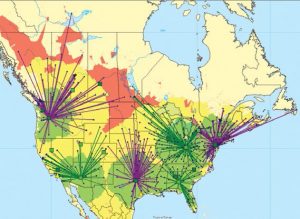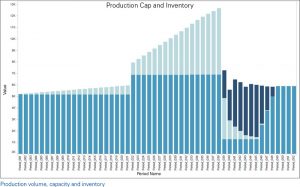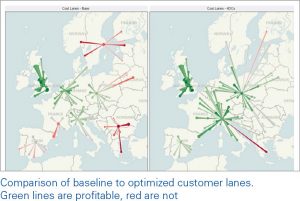How Food and Beverage Companies Are Using Supply Chain Design
For food and beverage companies, time is everything. That being said, any company that is able to design a supply chain that improves speed and efficiency gains a competitive advantage in the market. One way companies have been doing this is through modeling. For example, in the picture that follows, this specific company has mapped out the service time to different geographic regions that are defined by the shaded areas. The power of modeling allows this service-area map to be reduced down to the street-level details: 
Another problem that food and beverage companies face is the classic “make vs. buy” challenge. Taking into account the current supply chain design, a company must determine whether it should produce a new product in its own facility or contract this production to another company. As we have learned in class, this requires the company to forecast 3, 5, or even 10 years into the future and examine how much the two different projects would differ on costs and plausibility. When designing a new supply chain, a company must consider if they have future plans on expansion as well. Not only does it take a great deal of analysis when considering an addition to a company, it takes even more when creating the initial design as it must support the company as it grows and expands.
As was mentioned earlier, the ultimate goal of food and beverage companies in particular is speed and efficiency because fresh food is the number one priority. Unlike other companies that might simply face backlash and complaints from a customer if a product is late, some food and beverage companies have to deal with products that have limited shelf lives. Not only will the customer be upset because an order in late, but they might also not be able to put the product on the shelves at all. Therefore, it is vital that these companies can predict inventory levels, service rates, and any site capacity restraints that they might have in order to maximize their supply chain. As we have seen in class, this can be a tall task that requires a great deal of experience in the company as well as an understanding of market trends to be able to accurately predict all these variables. Luckily, firms can also utilize supply chain simulation to aid in the decision-making process. Using this method produces a graph that looks similar to the one that follows:

Finally, it is important for companies to constantly analyze its own supply chain to spot inefficiencies and opportunities to eliminate non-profitable aspects of the supply chain. Continuing with the food and beverage example, it could be parts of the geographical market that would be better served by contracting out shipping, manufacturing, or any part of the supply chain. Also, as in the example that follows, it might be best for a company to focus its resources on fewer locations. In the following picture, the lines represent optimized customer lanes. Green lines are profitable and red lines are not:

Supply chain design requires constant monitoring and a high level of expertise to be successful. Can you think of another industry where supply chain design is vital to the success of the firm? Or is there a specific example that comes to mind when you think of successful supply chain design?
For further reading, please refer to the two articles I used when writing this post:
Brian,
Thank you for your post about some of the challenges faced by food and beverage companies in their supply chain design processes. To go further into the problems they face, I found this article from supplychainbrief.com that discusses the 5 T’s of the global food supply chain.
One important one is transparency: collaboration in the foodservice supply chain. For a global company such as McDonald’s (or any fast food company), they more than likely receive their foods from different parts of the globe. For example, A European restaurant may receive its beef from America and its tomatoes from a country in South America. It is important, as has been discussed in my international marketing class, to have transparency with these partners for a more efficient and effective supply chain.
http://www.supplychainbrief.com/2017/food/supply-chain/?open-article-id=6299657&article-title=the-five-ts-of-the-global-food-supply-chain&blog-domain=supplychainbeyond.com&blog-title=the-network-effect
Brian,
I really liked this topic and I really liked the thought-provoking questions near the end.
I worked for the fast food/gas station/convenience store Wawa for two years. My job for a lot of my time there was working on inventory when it came in every other night from 9pm to 3am. One of the most difficult aspects of the job was reordering the food and the materials in the correct amount so as not to over supply ourselves. Obviously from our class activity, you can see that holding costs can be some of the most expensive costs of the firm. If we ordered too much meat, for example, that meat could go bad in a matter of days. Now that meat is a huge waste of money we could have made had we either sold more meat, or just avoided ordering too much in the first place. Great topic. It is very relevant to not only class but also to everyday business.
Brian,
Your post did a nice job of discussing how an industry designs a supply chain in order to meet general competitive requirements of the industry. One of the most important aspects of a food or beverage company’s supply chain are their customers—i.e. retail outlets such as wholesalers, grocery stores, or convenience stores—that sell to the end consumer. A number of our peers discussed companies such as PepsiCo or Lay’s in their responses that reminded me of a recent WSJ article.
The article summarizes a recent Morgan Stanley report that discusses how companies such as PepsiCo or Altria Group could be materially hurt by the expansion of electric vehicles. Analysts site the fact that EV owners do the majority of their charging at home, and the current gas station model that conventionally powered vehicles use is unlikely to be the model of fueling vehicles in the future (WSJ 1). Given the fact that gas stations represent a major distribution channel for products such as Lay’s, some Morgan Stanley analysts are asking an important question about companies such as PepsiCo: How disruptive will the decline in gas stations be to their top and bottom line growth (WSJ 1)?
As EV growth continues to expand, and new solutions to meet EV owners charging needs continue to evolve, firms like PepsiCo will have a major supply chain issue on their hands. I think it is reasonable convenience stores (without gas stations attached) will continue to exist, but I certainly have questions about what share of PepsiCo’s sales of products such as Lay’s or Soda are attributed to gas stations. This uncertainty will make it imperative that PepsiCo finds new distribution channels for their products.
Words: 280
WSJ 1: https://blogs.wsj.com/moneybeat/2018/03/30/where-will-you-buy-cigarettes-and-slim-jims-when-you-dont-need-to-stop-for-gas/
Brian,
Great post regarding the ins and outs of the food and beverage industry’s supply chain. Within that industry, I’d like to look at Lay’s chips who have been owned by PepsiCo since the 1960s. After watching the video in class today about Bean Babies (the coffee pot), I was inspired to look at brands who offer different flavors or options in different areas. Just like the company from today’s video offers Bean Babies in most European countries except for Italy, Lay’s offers and ships specific flavors to Canada that are not offered in the US. Some of the flavors include Ketchup, Smokey Bacon, and Poutine. For a full list of flavors and a glance at other brands who offer different flavors around the world, check out this link:
http://mentalfloss.com/article/28758/8-american-snacks-their-foreign-flavors
Shipping exclusive flavors to specific countries or areas adds even more complexity to Lay’s supply chain, but they handle it well. For most of Lay’s chips, their supply chain begins in India with potato farming. PepsiCo owns and operates a few different potato processing sites in India, and from there, potatoes are shipped to different manufacturing sites around the world. Lay’s also uses American grown potatoes, many of which are shipped to their manufacturing plant in Connecticut. The manufacturing process is incredibly detailed, but some highlights can be found in the video below.
https://www.youtube.com/watch?v=ws_K9Cxs-uE
From there, the chips are sold to wholesalers, then to retailers, and then finally to customers. It’s an extensive supply chain, but Lay’s has been executing it brilliantly for years.
Additional Sources http://www.fao.org/fileadmin/user_upload/ivc/PDF/Asia/15_Punjabi_potato_contract_farming_for_Pepsi_India_formatted.pdf
Nick,
Thanks for your comment! Your example of Lay’s and how they offer different flavors and options in different countries is very interesting. In fact, we were talking about this concept today in my Consumer Behavior class.
In addition to offering different products in different countries, companies must pay close attention to how they market these products in each country. Companies can take one of three routes: global marketing, international marketing, or a hybrid of the two. Global marketing is selling the same product or service in several countries using the same marketing mix in each country. On the other hand, international marketing is adapting each product or service to each specific country using a different marketing mix that fits each country. A hybrid strategy is a combination of the two.
From your post, it sounds like Lay’s takes a customized, international approach. What an interesting connection between Operations Management and Consumer Behavior!
Nick & Lily,
I think this is a really interesting topic choice! It made me think about the wide variety of Kit Kat flavors that you will see all over social media and I decided to look more into it. I found out that like Lays, Nestle has taken an international marketing approach to Kit Kats in Japan. In the last 15 years, they are released over 200 flavors ranging from strawberry to soy sauce, which has made the chocolate confection the most popular candy in Japan. A representative for Nestle Japan said that their reasoning behind this is the connivence-store business model that is popular in the country. This model means that it is common for stores to stock their shelves with new products every couple of weeks. While they can always re-order popular products, it creates a demand for Kit Kat to constantly innovate new flavors and quickly produce them. Because of their huge success it is safe to assume that they have a very strong supply chain management team and strategy!
Sources;
http://www.foodrepublic.com/2015/07/20/there-are-more-than-200-different-flavors-of-kit-kats-in-japan-heres-why/
https://www.cbsnews.com/pictures/worlds-weirdest-kit-kat-candy-bars/
Brian,
Thanks for your interesting post! As you mentioned, the ultimate goal of food and beverage companies when managing their supply chain is speed and efficiency because fresh food is the number one priority. I believe that this same idea can be applied to the ice cream industry as well.
My dad worked as the Senior Vice President of Sales and Distribution for Edy’s Ice Cream until a few years ago. In conversations with him, I learned that the ice cream industry is an industry that requires tremendous precision when it comes to designing supply chains. Edy’s must ensure that their products maintained their quality as they were shipped from the manufacturing plant, to the distribution center, to the retailer, and into the hands of the consumer.
In particular, cold chain management is key when designing a supply chain. The cold chain’s enemy is heat shock, which is when ice cream warms up and refreezes and tends to become icy and grainy (which customers don’t like). “The risk of an unwanted temperature change tends to be highest when the ice cream is moving from one location—say, a manufacturing plant—to another, such as a delivery truck.”
The Internet of Things plays a major role in the proper transport of ice cream. IoT can monitor the refrigeration unit’s operation and sense when a truck’s cooling mechanism isn’t working properly and notify the driver that the ice cream needs to move from the truck to the freezer as quickly as possible once it arrives at the warehouse.
Source: http://www.inboundlogistics.com/cms/article/the-ice-cream-supply-chain-get-the-scoop/